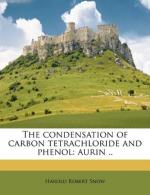|
This section contains 1,060 words (approx. 4 pages at 300 words per page) |

|
Overview
Carbon tetrachloride (CAR-bun tet-ra-KLOR-ide) is a colorless, nonflammable liquid with a sweetish odor and a density 1.5 times that of water. The compound is classified as a halogenated hydrocarbon because all of the hydrogens in methane (CH4), a hydrocarbon, have been replaced by halogen atoms (chlorine, in this case). Carbon tetrachloride was first prepared in 1839 by German-born French chemist Henri Victor Regnault (1810–1878). Regnault made carbon tetrachloride by reacting chloroform (trichloromethane; CHCl3) with chlorine: CHCl3 + Cl2 → CCl4 + HCl.
Key Facts
Other Names:
Tetrachloromethane; perchloromethane
Formula:
CCl4
Elements:
Carbon, chlorine
Compound Type:
Halogenated hydrocarbon; alkyl chloride (organic)
State:
Liquid
Molecular Weight:
153.82 g/mol
Melting Point:
−22.62°C (−8.72°F)
Boiling Point:
76.8°C (170°F)
Solubility:
Insoluble in water; miscible with ethyl alcohol, ether, benzene, chloroform, and most other organic solvents
Until the mid-twentieth century, carbon tetrachloride had a number of important applications, including use as a dry cleaning fluid, a refrigerant...
|
This section contains 1,060 words (approx. 4 pages at 300 words per page) |

|


